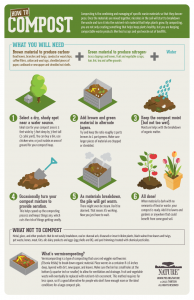What: This infographic is simple yet appealing and showcases all 3 effective forms of delivery. It is intellectually stimulating because it offers the information in a step by step process with pictures allowing the reader to easily comprehend and take action. It also shows relevancy to the audience by mentioning how compost can help their personal garden in step 6. Lastly, it is creative because at a glance the audience can understand the purpose and what to do but at the same time information is not compromised — everything from how to compost, do’s and don’ts of what should be put in compost, and different types of composting is included.
Gut: The graphic invoked a feeling of practicality allowing taking action to be easy. By showing step to step procedure with few words and pictures, it showcased that composting is not much extra work and is purposeful. The picture in step 6 showcased the usefulness in a glance, making people want to compost. It was pleasing to read, because of the way the infographic was set up – easy terms and not cluttered with words — extra stuff put on the bottom and important things boxed.
So What: Surprisingly, I had never thought that making compost was so easy and never realized the fruitful results it has – such as being able use it as fertilizer in my own garden. I thought it was too much work and never really saw the short-term benefit. This also seems like a financially and environmentally a good option due to being able to save money on fertilizers and recycling organic material. The source is pbs.com/nature. With this source, during class time we could go to this website and find more information on soil/composting and maybe even be able to elaborate on this infographic.
Now What: I think that making the steps of how to compost and what to compost is very important when talking to college students living in Rooker Hall/ECV community because they do not have the time to do research and if it is too complicated — students will not take part in the activity. Students have a lot going on in their day to day so we need to highlight purposeful and relevant information to them when giving them tasks. These things have not really come to light because we are all focusing on the research of composting that we are not looking at the delivery and outcome aspect.
.





